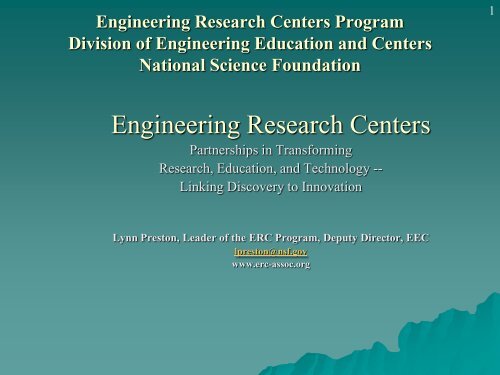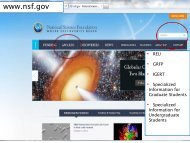Download this presentation (.pdf) - PREM
Download this presentation (.pdf) - PREM
Download this presentation (.pdf) - PREM
Create successful ePaper yourself
Turn your PDF publications into a flip-book with our unique Google optimized e-Paper software.
Engineering Research Centers Program<br />
Division of Engineering Education and Centers<br />
National Science Foundation<br />
1<br />
Engineering Research Centers<br />
Partnerships in Transforming<br />
Research, Education, and Technology --<br />
Linking Discovery to Innovation<br />
Lynn Preston, Leader of the ERC Program, Deputy Director, EEC<br />
lpreston@nsf.gov<br />
www.erc-assoc.org
2<br />
ERCs Build University Cultures that Join<br />
Discovery & Innovation in Partnership with Industry<br />
ERC Program Goals<br />
• Create a culture in academe that joins research, education, and<br />
innovation<br />
• Build partnerships with industry to strengthen the innovative<br />
capacity of the U.S. in a global context<br />
• Produce engineering graduates who are creative and innovative<br />
practitioner, more capable of leading teams to advance<br />
technology in established firms or leading new firms
3<br />
Core Key Features of Gen-2 and Gen-3 ERCs<br />
• Guiding strategic vision for transforming engineered systems and<br />
development of a diverse, globally competitive engineering<br />
workforce<br />
• Strategic plans for research, education, diversity to realize the<br />
vision<br />
• Systems-motivated interdisciplinary research program spanning<br />
discovery to engineered systems, enabled by testbeds<br />
• Cross-disciplinary, systems-focused education programs from<br />
pre-college to practitioners, produce graduates who can advance<br />
technology and speed technology transfer<br />
• Strong partnership with industry/practitioners to speed technology<br />
transfer and innovation
Resources<br />
Additional Gen-3ERC Key Features<br />
Gen-3 ERC bridge discovery to<br />
innovation by expanding the<br />
research culture to:<br />
• Support translational research<br />
with small firms.<br />
• Develop more creative &<br />
innovative engineers<br />
• Partner with economic<br />
development organizations<br />
• Partner with 1-3 foreign<br />
universities<br />
• Long-term pre-college<br />
partnerships<br />
• Reward mentoring<br />
ERCs on the Innovation Spectrum<br />
ERCs<br />
Academia<br />
Valley of the Shadow<br />
of Death<br />
Gen-3<br />
ERCs<br />
Small Business<br />
Investors<br />
Discovery Technology<br />
Development Commercialization<br />
Demonstration<br />
Level of Development<br />
Industry<br />
Adapted from slide created by Angus Kingon, Brown University
System Requirements<br />
ERC Strategic Framework:<br />
Testbed(s)<br />
Testbed(s)<br />
Systems Research<br />
Systems Research<br />
3-plane chart<br />
Testbed(s)<br />
Barriers<br />
Requirements<br />
Products & Outcomes<br />
Stakeholders<br />
Systems<br />
Technology Integration<br />
Technology Elements<br />
Testbeds<br />
Enabling Technology Research<br />
Barriers<br />
Testbeds<br />
Enabling Technology Research<br />
Testbeds<br />
Enabling Technologies<br />
Technology Base<br />
Fundamental Insights<br />
Fundamental Research<br />
Fundamental Research<br />
Barriers<br />
Fundamental Research<br />
Fundamental Research<br />
Fundamental Research<br />
Fundamental Research<br />
Fundamental Knowledge<br />
Knowledge Base
Post-Award<br />
Infrastructure Review Criteria,<br />
2. Diversity Effort<br />
• Diversity Strategic Plan: Strong strategic plan for diversity,<br />
benchmarked against national engineering averages, results demonstrate<br />
a strong and effective plan. Strong partnership for diversity with partner<br />
deans and department chairs.<br />
• Institutions Serving Large Underrepresented Populations: As lead,<br />
or core partners (Class of 2006 & higher) and affiliate partners<br />
• Women and Minority Alliances: Alliances with Louis Stokes Alliance<br />
for Minority Participation (LSAMP), and at least one other connection<br />
with an Alliance for Graduation Education of the Professoriate (AGEP)<br />
• Leadership Diversity: Team of leaders is diverse in gender, race, and<br />
ethnicity<br />
• Diverse Faculty and Student Involvement: A significant number of<br />
women, underrepresented racial and ethnic minorities, and persons with<br />
disabilities on the faculty and undergraduate and graduate student teams
Percentage Value<br />
Women in ERCs,<br />
FY2004–2009<br />
ASEE National Engineering Data<br />
NSF-NIH Postdoctorate Survey Data<br />
40<br />
35<br />
30<br />
25<br />
20<br />
15<br />
32<br />
22 23 23 24<br />
20<br />
19 20 19<br />
17<br />
17<br />
18<br />
34<br />
29<br />
30<br />
28<br />
25<br />
24<br />
31 31 31<br />
27 27 27<br />
38<br />
37 37<br />
35<br />
35<br />
32<br />
2004<br />
2005<br />
2006<br />
2007<br />
2008<br />
2009<br />
10<br />
5<br />
0<br />
Faculty Postdoctorate Doctoral Master's Undergraduates
Percentage Value<br />
Underrepresented Racial Minorities in<br />
ERCs,<br />
FY2004–2009<br />
ASEE National Engineering Data<br />
(Data for African-Americans and Native Americans)<br />
40<br />
35<br />
30<br />
25<br />
20<br />
15<br />
10<br />
5<br />
0<br />
4<br />
21<br />
20 19<br />
17<br />
14<br />
15<br />
13<br />
11<br />
9<br />
9<br />
7<br />
6<br />
7<br />
8<br />
8<br />
5 5<br />
5<br />
6<br />
4<br />
5<br />
4 5 5<br />
2 2<br />
1 1 1<br />
Faculty Postdoctorate Doctoral Master's Undergraduates<br />
2004<br />
2005<br />
2006<br />
2007<br />
2008<br />
2009
Percentage Value<br />
Hispanics in ERCs<br />
FY 2004–2009<br />
ASEE National Engineering Data<br />
40<br />
35<br />
30<br />
25<br />
20<br />
15<br />
13<br />
13<br />
13<br />
13<br />
2004<br />
2005<br />
2006<br />
2007<br />
2008<br />
2009<br />
10<br />
5<br />
0<br />
5<br />
9<br />
9<br />
7<br />
8<br />
8 7 7 8<br />
6<br />
7<br />
6<br />
7<br />
6<br />
5<br />
4<br />
4<br />
2 2<br />
1<br />
2<br />
2<br />
0 1 2<br />
0<br />
Faculty Postdoctorate Doctoral Master's Undergraduates
Puerto Rico Student Test Bed -<br />
ERC for Collaborative Adaptive Sensing of the Atmosphere<br />
EWR Radar<br />
FCC approved<br />
Operational<br />
Off-the-Grid Radar<br />
Two nodes being tested<br />
at UMass (FCC<br />
approved)<br />
Wireless<br />
Communications<br />
Energy Balanced<br />
Optimization<br />
Distributed<br />
MC&C<br />
Reflectivity<br />
Retrieval<br />
Rain rate<br />
estimates<br />
PR1<br />
(Stefani) Radar<br />
FCC approved<br />
Radar operational<br />
OTG siting based on<br />
Disaster Vulnerability<br />
Model
NSF Engineering Research Center for<br />
Revolutionizing Metallic Biomaterials
Status of NSF 09-545 and<br />
the Next ERC Competition<br />
ERC Solicitation NSF 09-545<br />
• Full Proposals Under Review<br />
• Site visits in August and September, 2010<br />
• Award decisions in November, 2010<br />
• Approval of award recommendations in January<br />
and February, 2011<br />
• Awards (5-7) in March or April, 2011<br />
Next ERC Solicitation<br />
• Plan to release in April 2011<br />
• Awards in 2013, at least 3




